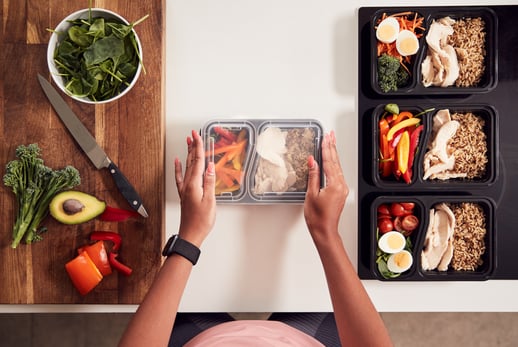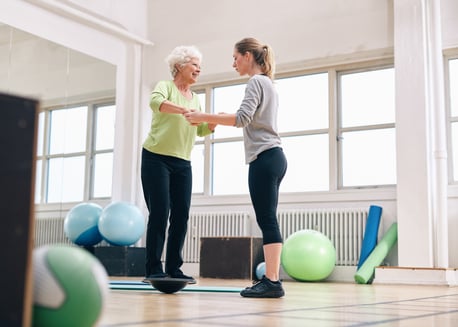 Are you hoping to start meal prepping to allow for more time during the weeknights? Meal-prepping is a great way to ensure you are eating a well-balanced diet, even when you are on a time crunch throughout the week. It can be a daunting and time-consuming task at first, so here are a few tips to get you started.
Are you hoping to start meal prepping to allow for more time during the weeknights? Meal-prepping is a great way to ensure you are eating a well-balanced diet, even when you are on a time crunch throughout the week. It can be a daunting and time-consuming task at first, so here are a few tips to get you started.
Organize your meal plans ahead of time and go grocery shopping ONCE.
First things first, decide what you want to prepare. Search through cookbooks or Pinterest for healthy meals that will reheat well. Write all of the required ingredients on your grocery list so that you only need to go shopping once. Once prepared, store your food in glass storage containers, if possible. Your food will reheat more evenly, and your hormones will thank you later!
Start small.
Instead of trying to prep EVERY meal for your entire week, start with just a few meals! If there are a few days of the week that you know will be busier than the rest, prioritize having meals ready-to-go for those specific days. As you get comfortable doing a few meals a week, you can decide whether you want to prep a little more at a time. It doesn’t have to be all or nothing!
Prioritize protein and vegetables.
Protein is key both for weight loss AND for gains. Choose proteins such as chicken breast or thighs, ground turkey, salmon, tuna, cod, beef, or even plant-based options such as quinoa, chickpeas, and beans. Incorporate plenty of colorful vegetables and healthy fats such as avocados, nuts, seeds, and cooking oils such as grass-fed butter, avocado oil (for high-heat) and olive oil (for dressings and low-heat). Sprinkle in complex carbohydrates full of fiber such as brown rice, quinoa, white or sweet potatoes with the peel, or orzo.
Keep lots of spices on-hand!
When you prep meals ahead of time, it may not take very long to get tired of eating the same foods. If you have a variety of spices in your kitchen ready to go, it can be a fun way to keep your meals new and exciting. This is a great time to experiment with seasonings such as curry, sazón, chimichurri, and more!
Prep your pantry with healthy snacks, too.
While pre-packaged foods are easy-to-grab, they often don’t provide many nutrients. Cut up some fruits and vegetables at the start of the week for grab-and-go snack options. Do the same with nuts and seeds – and put them all in easy, one-portion storage containers.


 Eating out at restaurants or on the go doesn’t have to break the calorie bank or bust your diet. Here are some tips and tricks for keeping your order healthy when eating out:
Eating out at restaurants or on the go doesn’t have to break the calorie bank or bust your diet. Here are some tips and tricks for keeping your order healthy when eating out: When you live with chronic pain, the only one who can know how much it hurts is you. Pain can be hard to describe because it’s both invisible and personal. If you can’t put into words how much pain you’re in or how it affects your life, your doctor, physical therapist or fitness trainer can’t prescribe the right treatment or exercises for you. Go through these questions to help you get the relief you need.
When you live with chronic pain, the only one who can know how much it hurts is you. Pain can be hard to describe because it’s both invisible and personal. If you can’t put into words how much pain you’re in or how it affects your life, your doctor, physical therapist or fitness trainer can’t prescribe the right treatment or exercises for you. Go through these questions to help you get the relief you need. 

 Improving balance can be tricky. Where do we start? What even is balance training? Standing on one leg? Walking more? It seems like everyone has their own idea of balance. What we do know, is that it becomes more important for active older adults to build and maintain balance with each passing year.
Improving balance can be tricky. Where do we start? What even is balance training? Standing on one leg? Walking more? It seems like everyone has their own idea of balance. What we do know, is that it becomes more important for active older adults to build and maintain balance with each passing year.
 If you’ve ever worked with older adults you likely know about this love/hate relationship everyone has with any program labeled “Fall Prevention”. Residents are certainly interested in learning about how to prevent falls. They have a healthy fear of falling. But often times, they don’t want to move outside of their comfort zone to practice the things that will actually improve balance and fall prevention.
If you’ve ever worked with older adults you likely know about this love/hate relationship everyone has with any program labeled “Fall Prevention”. Residents are certainly interested in learning about how to prevent falls. They have a healthy fear of falling. But often times, they don’t want to move outside of their comfort zone to practice the things that will actually improve balance and fall prevention.

.jpg?width=437&name=GettyImages-1279631867%20(1).jpg) When it come to health, certain fats can have a positive effect, whereas other can negatively impact your health. All fats are equal from a caloric standpoint meaning they all contain 9 calories per each gram of fat no matter the type. There are 3 main types of fat - saturated fats, monounsaturated fats, and polyunsaturated fats. The 2020-2025 Dietary Guidelines for Americans recommend that the
When it come to health, certain fats can have a positive effect, whereas other can negatively impact your health. All fats are equal from a caloric standpoint meaning they all contain 9 calories per each gram of fat no matter the type. There are 3 main types of fat - saturated fats, monounsaturated fats, and polyunsaturated fats. The 2020-2025 Dietary Guidelines for Americans recommend that the